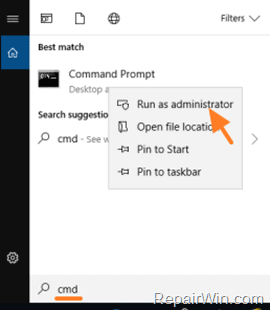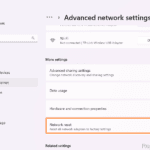.single .post-author, .post-date {
text-transform: none;
}
,
Last updated: November 5th, 2024
If you are experiencing network connectivity issues after updating to Windows 11 24H2, then in this guide you will find several solutions to fix them.
Symptoms: After installing the Windows 11 24H2 update, many users reported that they could not connect to the Network/Internet either with Wi-Fi or Ethernet (cable), with one of the following symptoms:
- The Network reports “Connected” but “Unidentified” because the network card (Wi-Fi or Ethernet) is not receiving a correct IP address from the DHCP server (the IP address begins with “169…”).
- The Wireless connecting capability is completely missing (Wi-Fi capability is unavailable).
- Wi-Fi is displayed as “Disconnected” and cannot be selected to connect to the Network.
- Unable to Enable the Wi-Fi or the Ethernet (LAN) adapter.
- The network card has stopped working.
How to Fix: Network Connectivity problems after installing Windows 11 24H2 update.
Method 1. Uninstall & Reinstall Network Adapters.
The first step to resolve the network connection problems after installing Windows 11 24H2 update, is to uninstall and reinstall the Network adapter(s). To do that:
1. Press Windows ![]()
![]() + R keys to open the run command box.
+ R keys to open the run command box.
2. Type: devmgmt.msc & click OK.


3. In Device Manager expand Network Adapters.
4. Right-click and select Uninstall Device to uninstall the Wireless and Ethernet adapters.*
* Note: At the ‘Uninstall Device – Warning message’, click Uninstall.


6. Restart your computer, wait a few minutes for Windows to reinstall the network adapters, and then check if the problem is resolved.
Method 2. Disable and Re-Enable Network Adapter(s).
1. Press Windows ![]()
![]() + R keys to open the run command box.
+ R keys to open the run command box.
2. Type: ncpa.cpl & click OK to open network connections.


3. Right-click on your network adapter and select Disable.


4. Now right-click on the network adapter again and select Enable. *
* Note: If after enabling the network adapter, it automatically returns to the “Disabled” state, then check your network adapter manufacturer’s site to see if there is a newer driver version for your network adapter and install it, or go to method 7, because there is no other way to fix this problem.
5. Wait few seconds, and then check if you can connect to the network.
Method 3. Reset Network.
1. Navigate to Start > Settings > Network & Internet > Advanced network settings and click Network Reset.


2. Then click Reset now and choose Yes to reset your network settings.


3. Finally click Close on the “You’re about to be signed-out out” notification message, close all your open programs, and restart the computer.


Method 4. Reset Winsock & TCP/IP.
1. Open Command prompt as Administrator. To do that:
- At Search box, type cmd or command prompt.
- Right click at Command Prompt result and select Run as Administrator.


2. In Command Prompt, type the following commands in order (press Enter after each command).
- netsh winsock reset
- netsh int ip reset


3. Restart your computer to apply the change.
Method 5. Disable TCP/IP v6 Protocol & Set Static IP Address.
1. Press Windows ![]()
![]() + R keys to open the run command box.
+ R keys to open the run command box.
2. Type: ncpa.cpl & click OK.


3. Right-click on your network adapter and select Properties.


4. Here, uncheck the Internet Protocol Version 6 (TCP/IPv6) to disable it, then select the Internet Protocol Version 4 (TCP/IPv4) protocol and click Properties.


5. Here, select Use the following IP Address & Use the following DNS server addresses and then specify manually the IP addresses.*
* Note: If you don’t know your network IP settings, leave these settings intact and click OK twice to apply only the TCP/IP protocol selection. Then check if the problem is resolved and if not, proceed to the next method.


Method 6. Fix Windows 11 24H2 Network Connection problems using Registry.
1. Press Windows ![]()
![]() + R keys to open the run command box.
+ R keys to open the run command box.
2. Type regedit & click OK.


3. Now, navigate to the following path in registry
HKEY_LOCAL_MACHINESYSTEMCurrentControlSetServicesWcmsvc
4. At the right-pane open the DependOnService value.


5. Delete the “WinHttpAutoProxySvc” and click OK.


6. Close the registry editor, reboot your computer and check if the problem is solved.
Method 7. Rollback Windows 11 to 23H2 version.
If the above methods did not help you fix the problem, roll back your system to the previous version of Windows 11 (23H2) until Microsoft fixes the problem in a future release of Windows 11 24H2.
1. Navigate to Start > Settings > System > Recovery and click Go back.


2. On “Go back to earlier build” window, click Next.


3. When prompted to “Check for updates?” click No, thanks.


4. Then click Next and then Go back to earlier build to restore your system to the previous version of Windows 11.


5. After you restore your system to Windows 11 version 23H2, check if everything works, then block the automatic upgrade to Windows 11 24H2 until Microsoft fixes the issues.
That’s all folks! Which method worked for you?
Please leave a comment in the comment section below or even better: like and share this blog post in the social networks to help spread the word about this guide.

- Author
- Recent Posts
- FIX: Windows 11 24H2 Network connection problems. – November 5, 2024
- How to Block Windows 11 24H2 Update/Upgrade. – October 28, 2024
- How to Install Windows 11 24H2 on unsupported hardware. – October 21, 2024


